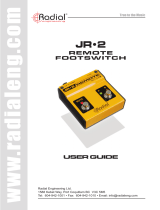
True to the Music
®
Radial Engineering Ltd.
EXTC-SA
3
GETTING STARTED
Before making any connections, start by turning off your audio system and turning all
volume levels down. This helps protect equipment from turn-on transients that could damage
loudspeakers and other sensitive equipment. Connect the external power supply to the
EXTC-SA. There is no power switch. The EXTC-SA will power up as soon as you connect
the supply. An LED on the front panel will illuminate when power is connected.
Start by setting up the controls as follows:
1. Set the blend control to the wet position (fully-clockwise).
2. Make sure the PHASE INVERT is set to normal (switch outward).
3. Set the send and receive level controls at mid-way (12 o’clock).
Connections between the EXTC-SA and your pedals
are made via the unbalanced high impedance ¼”
LOOP-A & B jacks. Connections to the recording
system are made through the balanced XLR and ¼”
TRS inputs and outputs jacks.
Connect the +4dB output from your recorder to
the balanced INPUT on the rear panel. To send
the processed signal back, connect the balanced
EXTC-SA output back to your recording system
and route the signal to a new track. To connect your
pedals, simply patch from the high-Z ¼” SEND jack
to your pedal chain input. The output of the pedal
chain is returned to the EXTC-SA by connecting
to the RECV jack. We suggest you start with one
pedal patched into LOOP-A before connecting more
pedals to LOOP-B. This will make it easier to trouble
shoot when fi rst setting up the EXTC-SA.
Turn on the effect pedal and select LOOP-A by depressing the the front panel switch. An
LED will indicate LOOP-A is active. Press play on your recorder and send the track to the
EXTC-SA input. You should be able to monitor the return path in your recording system and
hear the effect. Separate SEND & RECEIVE controls make it easy to adjust the levels to
suit any effect device. Now, try varying the BLEND control by rotating it counter-clockwise
towards the dry setting to hear how the effect mixes with the original track. If you notice that
the signal is ‘thinning out’ when the BLEND control is around the 12 o’clock position the wet
and dry signals may be out-of-phase with each other. The ‘thinning out” is the result of phase
cancellation between the wet and dry signals. Try depressing the PHASE INVERT switch to
fi x the problem. If all is well, try adding more pedals and connecting LOOP-B.
Once you get the EXTC hooked up, you will fi nd it to be loads of fun! All of a sudden, you
will be going back into the attic looking for that box of forgotten pedals, dusting them off
and plugging them in. Some will sound fantastic, others will sound bad in a good way. Who
knows, only those brave enough to enter blindly into these cold waters may live to tell the
tale. One of the most common applications for the EXTC-SA is using it to add grit to a vocal
track. This can easily be done with a distortion or overdrive pedal. You will fi nd that the most
realistic effects are created by blending slight amounts of distortion with the dry signal. But
you can also have loads of fun creating Nine Inch Nails type tones and generally going crazy.
There are no rules, only guidelines.














